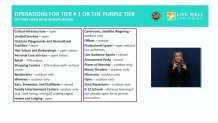It's official: San Diego County was shifted to the most-restrictive tier in California's color-coded system of coronavirus-related tiers.
The state updated its coronavirus Blueprint for a Safer Economy website on Tuesday and moved the region into Tier 1, which is also known as the purple tier. The shift comes amid rising cases of COVID-19 in San Diego County, reflected in the region's adjusted case rate, which was 8.9 for the week leading up to and including Halloween.
The possibility had been looming since the California Department of Public Health reported in late October that San Diego County’s COVID-19 case rate rose to 7.4, which is above the 4.0 to 7.0 case rate required for the Red Tier. If any county is above the 7.0 threshold for two consecutive weeks, it will be moved into the most-restrictive tier, which became San Diego County's reality on Tuesday.
San Diego was among three counties -- including Sacramento and Stanislaus --that moved to the purple tier on Tuesday.
Tier 1 means there is a "widespread" risk of contracting COVID-19, according to California Public Health officials. As the most restrictive tier of the four, Tier 1 mandates the following:
- Restaurants must cease indoor operations; can still offer services outdoors
- Places of worship can offer services outdoors but must stop indoor services
- Gyms and fitness centers must take services outdoors and halt indoor services
- Retail stores and bookstores can open with a maximum 25% capacity
- Grocery stores, which are considered essential, can continue operations with a maximum 50% capacity
- Breweries, bars, distilleries and wineries where meals are not provided must close
- Museums, Zoos and aquariums can open outdoors only with modifications.
- Any schools that haven't already reopened in any capacity must keep their campuses closed until San Diego advances to the red tier. Exceptions are elementary schools that have not yet utilized their waivers, and any campus that is in the middle of a temporary campus closure due to COVID-19 cases among students and staff
The state is allowing businesses a three-day grace period before they must comply with purple-tier rules. This means that the changes go into effect at 12 a.m. Saturday.

As for what's behind the county's regression, Public Health Officer Wilma Wooten spoke of "COVID fatigue" at the county briefing on Tuesday and pointed to worsening coronavirus metrics across the nation as evidence of people just being "fed up."
"We are, too, to be quite honest with you," Wooten said. "But we have to stay the course, and we have to do what we know works to decrease the spread of COVID-19 until there is a vaccine."
Supervisor Nathan Fletcher said the county was "lulled into complacency.”
“Unfortunately, COVID-19 doesn’t get complacent, it doesn’t get fatigued, it doesn’t get tired," Fletcher said.
Advancing to the red tier would require two consecutive weeks of a case rate below 7.1 and a testing positivity rate below 8.1%. The state assesses counties every Tuesday, so San Diego County will stay in the purple tier for at least the next three weeks.
Starting Thursday, the county is going to post weekly updates detailing case rates and testing positivity rates by municipalities and ZIP codes.
Offering services outdoors could prove to be difficult for businesses since temps will continue to get colder as we get closer and closer to winter, though it is possible for business owners to accommodate customers in chillier conditions with heat lamps.
var divElement = document.getElementById('viz1605056811624'); var vizElement = divElement.getElementsByTagName('object')[0]; if ( divElement.offsetWidth > 800 ) { vizElement.style.minWidth='700px';vizElement.style.maxWidth='920px';vizElement.style.width='100%';vizElement.style.height='500px';} else if ( divElement.offsetWidth > 500 ) { vizElement.style.minWidth='700px';vizElement.style.maxWidth='920px';vizElement.style.width='100%';vizElement.style.height='500px';} else { vizElement.style.width='100%';vizElement.style.height='600px';} var scriptElement = document.createElement('script'); scriptElement.src = 'https://public.tableau.com/javascripts/api/viz_v1.js'; vizElement.parentNode.insertBefore(scriptElement, vizElement);
"Our businesses are being forced to sacrifice their operation," Supervisor Nathan Fletcher said. "And these are business that when they formed never dreamt of a day or imagined a scenario or situation when they would have limitations on doing what they were founded to do."
Fletcher encouraged San Diegans to continue patronizing businesses if possible, such as keeping gym memberships open even if they may not be going or continuing to order takeout when restaurants close indoor operations.
Wooten sent a letter to local law enforcement agencies asking for increased efforts around enforcement. There are also compliance teams standing by to order closures or issue cease-and-desist letters if necessary, according to Fletcher.
To report a violation to the county enforcement team, you can call (858) 694-2900 or send an email to SafeReopningComplianceTeam@sdcounty.ca.gov.
"If there is a future stimulus package, which we hope there is, we hope that it will include money for businesses and cities so we can help," Supervisor Greg Cox said.
Fletcher said the county is working with hotels and short-term rental companies to ensure compliance in that sector. It's also distributing 40,000 masks to law enforcement agencies countywide in an effort to enforce mask mandates.
County supervisors also mentioned concerns about the impacts on businesses that have been compliant and not contributing to any rises in cases. Wooten said the county had made arguments to protect specific businesses or sectors from restrictions, but those entreaties were rejected.
Business owners told NBC 7 that the pandemic has taken them on a bumpy ride for the past several months and that they worry that the colder weather will impact their financial health.
“It was great when the days were warmer, nicer, the sun was out,” said Sandy Tobin, owner of the Dumpling Inn & Shanghai Saloon in Kearny Mesa. “But as we’re getting into the rainy season and cooler weather, people don't really want to dine outside.”
Dr. Mark Ghaly, California's Health and Human Services Secretary, provided an update Tuesday on the state's coronavirus cases, saying that a number of counties are seeing a surge in COVID-19 cases.
When asked if he was communicating with San Diego County leaders regarding indoor businesses, Ghaly said he is in contact with all counties on the matter.
"With every county, especially counties that are increasing in spikes, we're always in close dialogue," Ghaly said.



